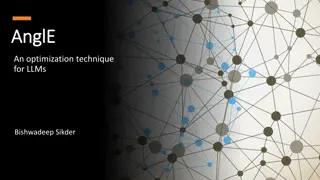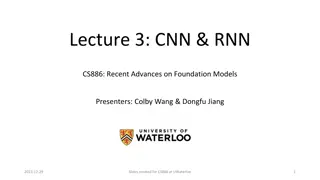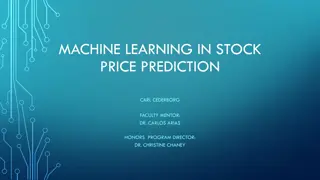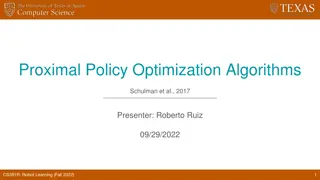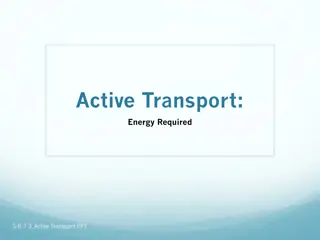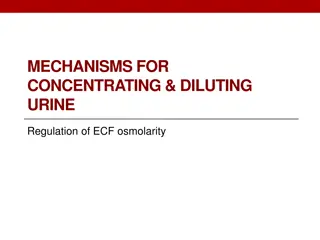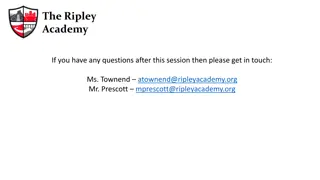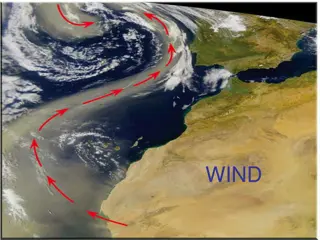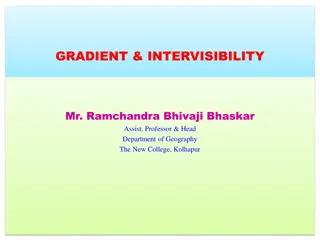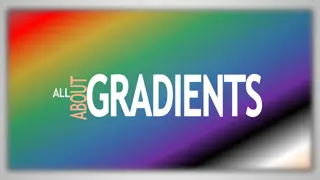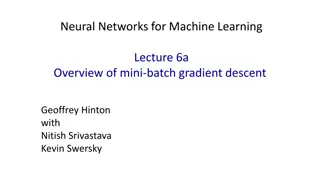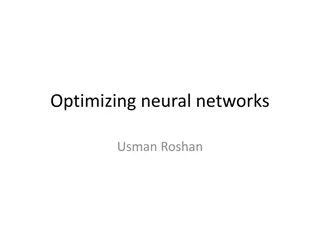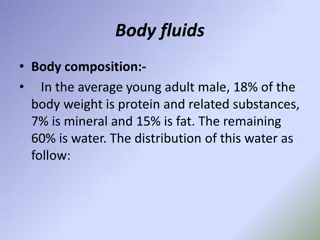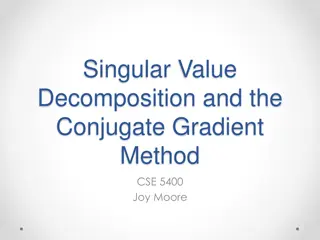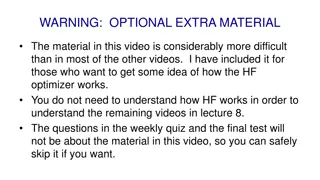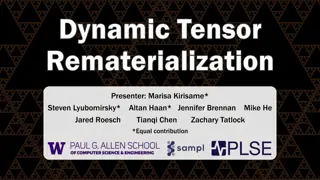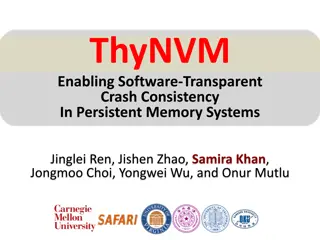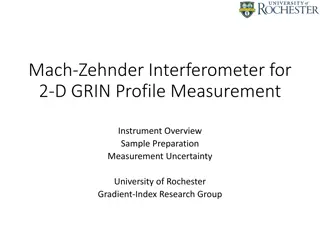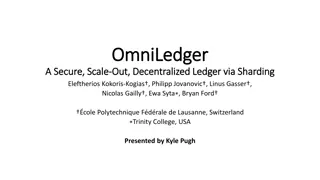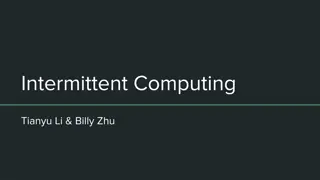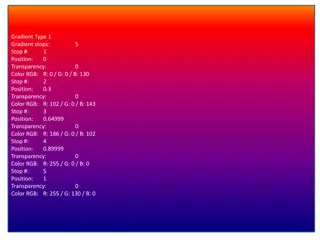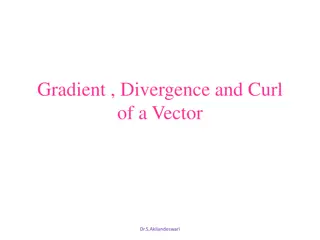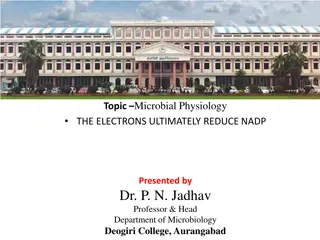AnglE: An Optimization Technique for LLMs by Bishwadeep Sikder
The AnglE model introduces angle optimization to address common challenges like vanishing gradients and underutilization of supervised negatives in Large Language Models (LLMs). By enhancing the gradient and optimization processes, this novel approach improves text embedding learning effectiveness.
9 views • 33 slides
Basic Principles of MRI Imaging
MRI, or Magnetic Resonance Imaging, is a high-tech diagnostic imaging tool that uses magnetic fields, specific radio frequencies, and computer systems to produce cross-sectional images of the body. The components of an MRI system include the main magnet, gradient coils, radiofrequency coils, and the
2 views • 49 slides
Understanding Alluvial Fans: Formation, Characteristics, and Morphology
Alluvial fans are cone-shaped landforms formed by streams carrying sediments from mountains onto plains. They are prominent in arid to semi-arid regions and vary in size from a few meters to over 150 kilometers. The different zones of an alluvial fan, including the fan apex and distal fan, display d
5 views • 9 slides
Do Input Gradients Highlight Discriminative Features?
Instance-specific explanations of model predictions through input gradients are explored in this study. The key contributions include a novel evaluation framework, DiffROAR, to assess the impact of input gradient magnitudes on predictions. The study challenges Assumption (A) and delves into feature
0 views • 32 slides
Recent Advances in RNN and CNN Models: CS886 Lecture Highlights
Explore the fundamentals of recurrent neural networks (RNNs) and convolutional neural networks (CNNs) in the context of downstream applications. Delve into LSTM, GRU, and RNN variants, alongside CNN architectures like ConvNext, ResNet, and more. Understand the mathematical formulations of RNNs and c
1 views • 76 slides
Understanding Machine Learning for Stock Price Prediction
Explore the world of machine learning in stock price prediction, covering algorithms, neural networks, LSTM techniques, decision trees, ensemble learning, gradient boosting, and insightful results. Discover how machine learning minimizes cost functions and supports various learning paradigms for cla
2 views • 8 slides
Statistical Modeling of Pore-Scale Intermittency and Ostwald Ripening
Using a statistical approach, this research delves into the pore-scale modeling of intermittency and Ostwald ripening in two-phase flows. The study challenges the traditional linear relationship between pressure gradient and capillary number, highlighting the impact of fluid intermittency on flow be
0 views • 15 slides
Understanding Electromigration Effects in IC Interconnect Lines
Background: As IC circuits advance, preventing failures like electromigration is crucial. Vacancies lead to potential failures in metal interconnects by causing macroscopic voids and hillocks. Explore the governing equations and physics interfaces behind the migration of vacancies in IC circuits. Im
0 views • 14 slides
Understanding Hypokalemia and Potassium Regulation
Hypokalemia is a condition characterized by low potassium levels, crucial for intracellular functions. The Na+/K+ ATPase pump maintains the ICF/ECF gradient. Potassium excretion occurs mainly via the kidneys, with minimal variation in proximal tubule reabsorption. The collecting duct plays a vital r
2 views • 50 slides
Advanced Reinforcement Learning for Autonomous Robots
Cutting-edge research in the field of reinforcement learning for autonomous robots, focusing on Proximal Policy Optimization Algorithms, motivation for autonomous learning, scalability challenges, and policy gradient methods. The discussion delves into Markov Decision Processes, Actor-Critic Algorit
6 views • 26 slides
Understanding Active Transport: Energy-Driven Cellular Processes
Active transport is a vital process in cells that require energy in the form of ATP to move materials across the plasma membrane against their concentration gradient. This process involves pumps, endocytosis, and exocytosis. The sodium-potassium pump in nerve cells is a classic example of active tra
0 views • 9 slides
Understanding Artificial Neural Networks From Scratch
Learn how to build artificial neural networks from scratch, focusing on multi-level feedforward networks like multi-level perceptrons. Discover how neural networks function, including training large networks in parallel and distributed systems, and grasp concepts such as learning non-linear function
1 views • 33 slides
Isolation of AM Fungi by Wet Sieving and Sucrose Gradient Methods
Wet sieving is a popular technique to isolate different sizes of spores from soil samples. Developed by Gerdemann and Nicolson in 1963, this method involves passing an aqueous suspension through different sieves to collect spores of varying sizes. The process includes agitating the soil-water mixtur
0 views • 14 slides
Understanding Mechanisms for Concentrating & Diluting Urine in Maintaining ECF Osmolarity
Explore the intricate processes involved in concentrating and diluting urine to regulate extracellular fluid (ECF) osmolarity through mechanisms like the loop of Henle and vasa recta. Understand the factors influencing the ability to create a concentrated medullary gradient, differentiate water diur
0 views • 26 slides
A-Level Maths Overview and Study Resources
A comprehensive overview of A-Level Maths curriculum focusing on exam boards, assessment structure, recommended resources, and calculators. Includes insights into Mechanics and Statistics. Additionally, guidance on accessing supplementary learning materials and solving a math problem related to find
1 views • 27 slides
Forces Affecting Air Movement: Pressure Gradient Force and Coriolis Force
The pressure gradient force (PGF) causes air to move from high pressure to low pressure, with characteristics including direction from high to low, perpendicular to isobars, and strength proportional to isobar spacing. The Coriolis force influences wind direction due to the Earth's rotation, making
0 views • 20 slides
Understanding Slope, Gradient, and Intervisibility in Geography
Explore the concepts of slope, gradient, and intervisibility in geography through detailed descriptions and visual representations. Learn about positive, negative, zero, and undefined slopes, the calculation of gradient, and the significance of understanding these aspects in various engineering and
0 views • 12 slides
A Comprehensive Guide to Gradients
Gradients are versatile tools in design, allowing shapes to transition smoothly between colors. Learn about gradient types, preset options, creating your own metallic gradients, and applying gradients effectively in this detailed guide. Explore linear and radial gradient directions, understand gradi
0 views • 7 slides
Mini-Batch Gradient Descent in Neural Networks
In this lecture by Geoffrey Hinton, Nitish Srivastava, and Kevin Swersky, an overview of mini-batch gradient descent is provided. The discussion includes the error surfaces for linear neurons, convergence speed in quadratic bowls, challenges with learning rates, comparison with stochastic gradient d
0 views • 31 slides
Efficient Gradient Boosting with LightGBM
Gradient Boosting Decision Tree (GBDT) is a powerful machine learning algorithm known for its efficiency and accuracy. However, handling big data poses challenges due to time-consuming computations. LightGBM introduces optimizations like Gradient-based One-Side Sampling (GOSS) and Exclusive Feature
0 views • 13 slides
Understanding Optimization Techniques in Neural Networks
Optimization is essential in neural networks to find the minimum value of a function. Techniques like local search, gradient descent, and stochastic gradient descent are used to minimize non-linear objectives with multiple local minima. Challenges such as overfitting and getting stuck in local minim
0 views • 9 slides
Optimization Methods: Understanding Gradient Descent and Second Order Techniques
This content delves into the concepts of gradient descent and second-order methods in optimization. Gradient descent is a first-order method utilizing the first-order Taylor expansion, while second-order methods consider the first three terms of the multivariate Taylor series. Second-order methods l
0 views • 44 slides
Understanding Body Fluids and Composition in the Human Body
The body composition of an average young adult male includes protein, mineral, fat, and water in varying proportions. Water is the major component, with intracellular and extracellular distribution. Movement of substances between compartments occurs through processes like simple diffusion and solven
0 views • 37 slides
Understanding Singular Value Decomposition and the Conjugate Gradient Method
Singular Value Decomposition (SVD) is a powerful method that decomposes a matrix into orthogonal matrices and diagonal matrices. It helps in understanding the range, rank, nullity, and goal of matrix transformations. The method involves decomposing a matrix into basis vectors that span its range, id
0 views • 21 slides
Understanding Hessian-Free Optimization in Neural Networks
A detailed exploration of Hessian-Free (HF) optimization method in neural networks, delving into concepts such as error reduction, gradient-to-curvature ratio, Newton's method, curvature matrices, and strategies for avoiding inverting large matrices. The content emphasizes the importance of directio
0 views • 31 slides
Understanding Gradient Boosting and XGBoost in Decision Trees
Dive into the world of Gradient Boosting and XGBoost techniques with a focus on Decision Trees, their applications, optimization, and training methods. Explore the significance of parameter tuning and training with samples to enhance your machine learning skills. Access resources to deepen your unde
1 views • 9 slides
Overcoming Memory Constraints in Deep Neural Network Design
Limited availability of high bandwidth on-device memory presents a challenge in exploring new architectures for deep neural networks. Memory constraints have been identified as a bottleneck in state-of-the-art models. Various strategies such as Tensor Rematerialization, Bottleneck Activations, and G
0 views • 32 slides
Enhancing Crash Consistency in Persistent Memory Systems
Explore how ThyNVM enables software-transparent crash consistency in persistent memory systems, overcoming challenges and offering a new hardware-based checkpointing mechanism that adapts to DRAM and NVM characteristics while reducing latency and overhead.
0 views • 37 slides
Exploration of Thermodynamics in SU(3) Gauge Theory Using Gradient Flow
Investigate the thermodynamics of SU(3) gauge theory through gradient flow, discussing energy-momentum stress pressure, Noether current, and the restoration of translational symmetry. The study delves into lattice regularization, equivalence in continuum theory, and measurements of bulk thermodynami
0 views • 40 slides
Understanding Linear Regression and Gradient Descent
Linear regression is about predicting continuous values, while logistic regression deals with discrete predictions. Gradient descent is a widely used optimization technique in machine learning. To predict commute times for new individuals based on data, we can use linear regression assuming a linear
0 views • 30 slides
Understanding Linear Regression and Classification Methods
Explore the concepts of line fitting, gradient descent, multivariable linear regression, linear classifiers, and logistic regression in the context of machine learning. Dive into the process of finding the best-fitting line, minimizing empirical loss, vanishing of partial derivatives, and utilizing
0 views • 17 slides
Mach-Zehnder Interferometer for 2-D GRIN Profile Measurement
Mach-Zehnder Interferometer is a powerful tool used by the University of Rochester Gradient-Index Research Group for measuring 2-D Gradient-Index (GRIN) profiles. This instrument covers a wavelength range of 0.355 to 12 µm with high measurement accuracy. The sample preparation involves thin, parall
0 views • 6 slides
OmniLedger: Decentralized Ledger with Sharding
OmniLedger is a decentralized ledger using sharding to enhance scalability without compromising security. It addresses challenges such as validator selection, cross-shard transactions, and checkpointing. The proposed solution includes ByzCoinX for consensus and Atomix for atomic commit. Goals includ
0 views • 13 slides
Understanding Vanilla Universe Checkpointing and Its Challenges
Vanilla universe checkpointing involves saving sufficient state information to allow restarting execution without losing previous work. However, this process is challenging due to contextual dependencies in the state of processes, leading to complexities in managing checkpoints effectively.
0 views • 16 slides
Intermittent Computing: A Look into Energy-Harvesting Devices and Key Challenges
Intermittent computing, exemplified by energy-harvesting devices like the WISP RF-powered platform, poses challenges such as unreliable power leading to computation stoppages. Common techniques like checkpointing and task-based computation are employed to ensure progress and correctness in this cont
0 views • 42 slides
Gradient Types and Color Patterns
The content describes various gradient types and color patterns using RGB values and positioning to create visually appealing transitions. Each gradient type showcases a unique set of color stops and positions. The provided information includes detailed descriptions and links to visual representatio
0 views • 24 slides
Understanding Gradient, Divergence, and Curl of a Vector with Dr. S. Akilandeswari
Explore the concepts of gradient, divergence, and curl of a vector explained by Dr. S. Akilandeswari through a series of informative images. Delve into the intricacies of vector analysis with clarity and depth.
0 views • 13 slides
Unsteady Hydromagnetic Couette Flow with Oscillating Pressure Gradient
The study investigates unsteady Couette flow under an oscillating pressure gradient and uniform suction and injection, utilizing the Galerkin finite element method. The research focuses on the effect of suction, Hartmann number, Reynolds number, amplitude of pressure gradient, and frequency of oscil
0 views • 17 slides
Essential Tips for Training Neural Networks from Scratch
Neural network training involves key considerations like optimization for finding optimal parameters and generalization for testing data. Initialization, learning rate selection, and gradient descent techniques play crucial roles in achieving efficient training. Understanding the nuances of stochast
0 views • 23 slides
Understanding Microbial Physiology: The Electron-NADP Reduction Pathway
Dr. P. N. Jadhav presents the process where electrons ultimately reduce NADP+ through the enzyme ferredoxin-NADP+ reductase (FNR) in microbial physiology. This four-electron process involves oxidation of water, electron passage through a Q-cycle, generation of a transmembrane proton gradient, and AT
0 views • 29 slides
